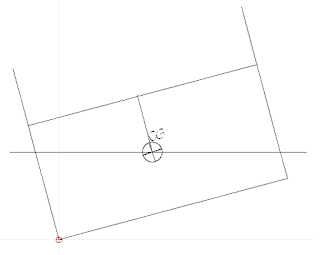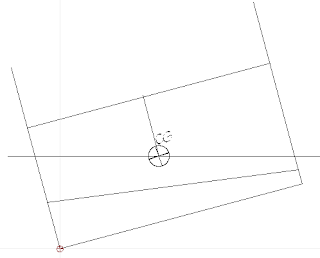The
stable Farmer
In
his book, My Old Boat Shop,WestonFarmer observed that he had discovered a rule of thumb target for
comfort at sea and that was the pounds per square foot loading of the
waterplane. He surmised that the optimum loading was 64 pounds per
square foot of the waterplane, or to put it another way the
underwater volume should be the area of the waterplane times 1 foot.
He theorized that this would make the vessel the same weight as the
sea surrounding it and thus the vessel would move with the sea not
out of sync with it as would a lighter or heavier vessel. But what
about the stability of such a vessel?
This
idea intrigued me so I did some follow up. To dissect this theory
we'll use a closed box 10' long by 4' wide and 2' deep. In the first
iteration the box weighs 64 lbs per cubic foot or 128lbs per sqft of
waterplane.
The
green line is the waterline, the centre of gravity and the centre of
buoyancy coincide. Logic tells you that this arrangement would not be
very stable as it would rotate about the centres completely
underwater. Add some sides,
Stability
increases but comfort doesn't as the boat would move out of sync with
the movement of the water. A wave passing through would start the
boat moving upwards but not at the speed of the wave. As the wave
passed and the trough arrived the boat would continue upwards due to
inertia and then start to fall as the next wave arrived creating a
very uncomfortable motion.
So
what would happen if we loaded the boat as Mr. Farmer suggests?
Here
it is,
Mr.
Farmer's theory is that this loading would be very comfortable as the
boat would move in sync with the water, Stability is much improved as
the centre of bouyancy is now below the center of gravity and would
move outboard as the boat heeled. Let's take a look at how that would
work.
Here
is our box boat at 40 degrees of heel,
However
the immersed volume is too great so we must adjust the waterline (WL) and
then determine the center of buoyancy, which is a piece of cake with
a triangle.
You
all remember your basic geometry of course. From that we can
determine the metacentric height for that angle of heel and the
righting arm.
But
what did I discover? Here it is - If you look at the diagram above
where we found the center of the triangle you'll notice that the line
from the top left to the middle of the right side cuts though the
deck line exactly in the centre, from that we can deduce that the
center of buoyancy falls on a line joining the mid points of the two
parallel sides. But where on that line?
Jim
Michalak in a post here, http://www.jimsboats.com/1dec15.htm shows you how to find the centre of effort of a four sided sail, that
same method can be used with the above knowledge to find the center
of buoyancy of a four sided immersed section but without the math.
Here we go.
Here's
our boat at 15 degrees of heel, the immersed volume is four sided.
First
we join the two mid points,
Then
divide the four sided figure into two triangles, find the centre of
each and join the two centres.
Where
the two lines joining centres and midpoints cross is the center of
buoyancy.
But
will it work for boats that don't have two parallel sides or a round
bottom boats. Next time.










No comments:
Post a Comment